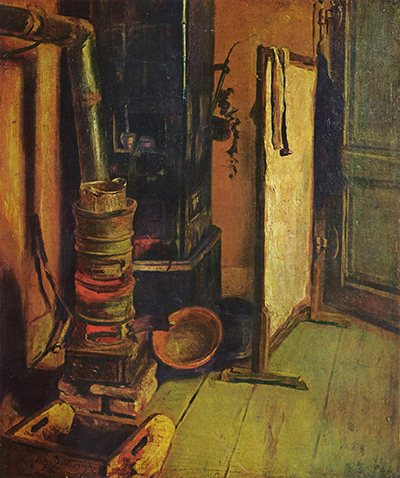This still life painting is dated at circa 1830 and is a part of the collection of the Louvre in Paris, who own a good number of paintings and drawings from Delacroix's career. It is represents a very rare venture by the artist into this particular genre.
Here we find an honest depiction of the artist's studio, complete with used pots that contained paint previously, as well as a screen to control light whilst working. There are rags to clean brushes and also a number of containers which would help the artist to organise his working area, with many different materials and tools needed to create the different effects that his paintings included. Many see only the final artwork, in all its polished beauty, and may be entirely unaware of the hard work and mess that can be created within the process. This composition helps to remind us that art was not all about fame and fortune, but also the reality of cleaning brushes, working and practicing tirelessly within a small studio and many other tasks that were necessary in order to create such an extensive and impressive oeuvre.
Depictions of one's studio are far more common than you might imagine, though normally they will include the artist himself at work, or perhaps a guest to the studio working away. Delacroix chooses a very informal topic here, and something that many academics would have struggled to accept and enjoy. They wanted symbolism, drama and all the other aspects that we find within Delacroix's best known works, but there is still much to appreciate here for everyone else. This Frenchman, however, did not want to restrict his talents in any way, and whilst he may have concentrated more on some extraordinary history paintings, as well as others inspired by more recent literature, he also dabbled consistently in other opportunities brought about by portraiture, still life and also landscape art. In some cases, he would use these skills together in merges of different content.
Delacroix may not have been famous for stil life work during his career but French art in general contributed some highly skilled specialists within this genre. Few can forget the brilliance of Jean-Baptiste-Simeon who took this art form to levels never seen before, creating paintings that were of almost photographic accuracy. Some of his best known pieces included Grapes and Pomegranates, Basket of Peaches and The Ray. He worked tirelessly in order to perfect his depictions and whilst the still life scene is not as popular as some others, there remains a deep academic respect for the technical work involved. Additionally, Paul Cezanne was also a supremely skilled still life artist, normally focusing on arrangements of fruit, such as with Still Life with Apples and The Basket of Apples.




